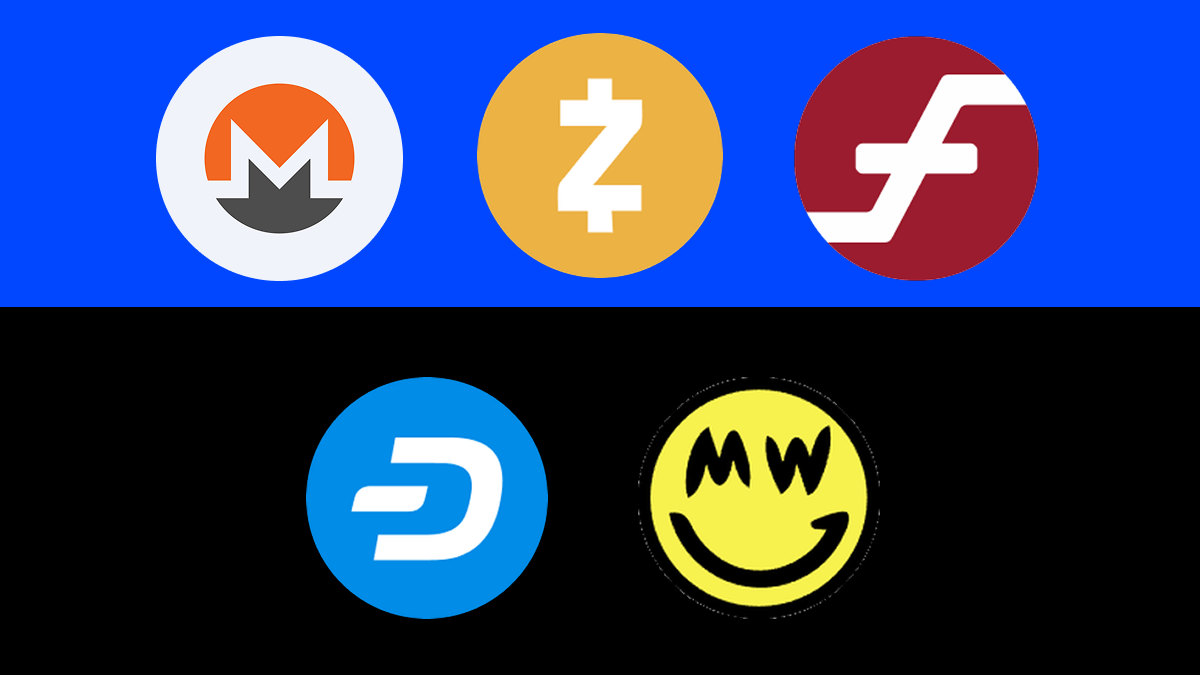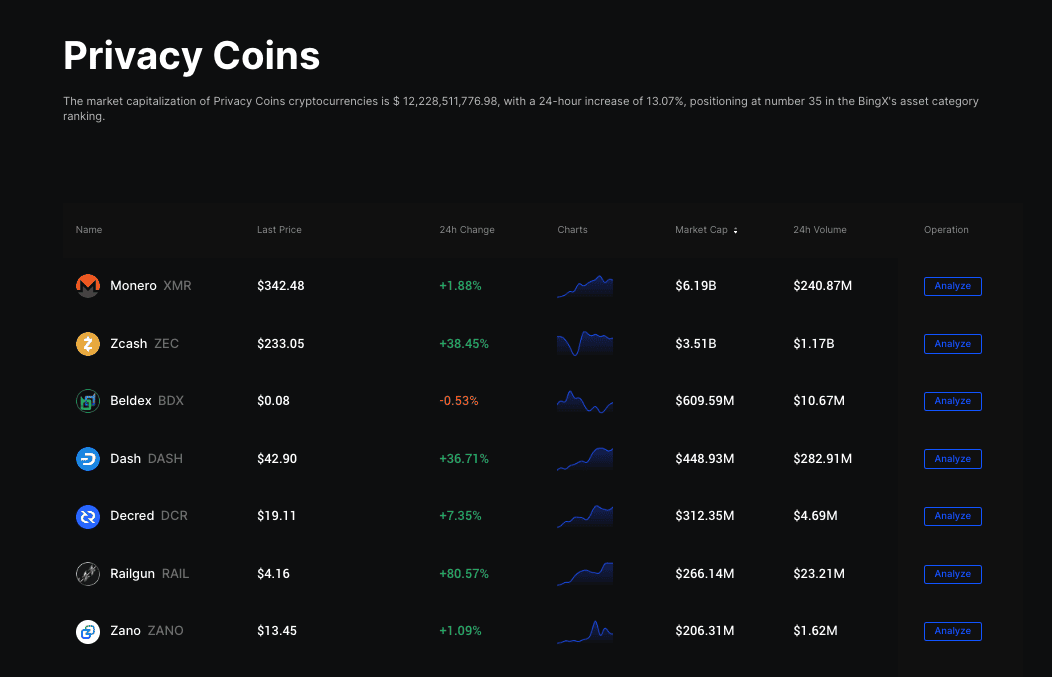Privacy coins matter again because price action says so.
Artemis data shows the privacy sector up about 120.2% in 2025, outpacing
Bitcoin at roughly 28.5% and beating
Ethereum, exchange tokens, and “store-of-value” assets across the same window. Zcash’s late 2025 spike, over 57% on the week and 382% on the month to roughly $233.05, put a spotlight back on private-by-design assets.
The tension is familiar: blockchain analytics improves each year, rules harden, and exchanges delist, yet traders still want on-chain confidentiality for use cases that range from personal finance to enterprise payments. Volatility and headline risk remain elevated.
Privacy Coins by market cap | Source: BingX
What Are Privacy Coins and What Makes One "Private"?
Privacy coins are
cryptocurrencies engineered to conceal parts of a transaction (sender, receiver, and amount) using cryptography, rather than relying on “security by obscurity” or front end tricks. Some projects are private by default (for example Monero), while others offer opt in privacy (for example Zcash’s shielded pool). That scope matters: there is a difference between identity privacy and transaction privacy.
In market terms, privacy also intersects with fungibility. Coins that hide provenance aim to prevent “tainting,” ensuring each unit is interchangeable and not reflexively discounted for past activity attached to an address, which is one reason many traders prefer private by design systems.
Here’s a simpler way to put it: privacy coins build privacy into the protocol itself, while privacy tools sit on top of transparent chains, like
mixers. Coins bake the cryptography into consensus and the transaction format. Tools only blur the trail and can run into throughput or coordination limits, and they often draw more regulatory attention. Think of Tornado Cash, which was sanctioned in August 2021.
What Are the Key Use Cases of Privacy Coins?
Here are some of the most popular use cases for privacy coins:
1. Personal finance and safety
If your on-chain salary, balances, or donations are visible, you become a target for profiling or phishing. Privacy coins shield amounts and counterparties, and some systems allow selective disclosure (e.g., view keys) for audits or taxes.
2. Business and institutional flows
Enterprises transacting on-chain may not want competitors to see payroll sizes, vendor lists, or treasury moves. Private-by-default designs can reduce leakage while retaining
cryptographic verifiability.
3. Censorship resistance and humanitarian contexts
Privacy tech counters surveillance, particularly where financial repression is a concern; this is frequently cited in project rationales and legal analyses debating whether privacy coins are inherently higher Anti-Money Laundering (
AML) risk than other assets. That said, enforcement heat is real and affects availability.
4. Portfolio angle
The 2025 rebound demonstrates that privacy coins can be used tactically to decouple from the main narratives, but they also experience delisting and sentiment shocks that move more quickly than those affecting large-cap majors.
What Are the Top 6 Privacy Coins to Watch in 2025?
Here are some of the most popular privacy tokens in the crypto market to watch this altcoin season:
1. Monero (XMR)
Monero makes privacy mandatory. Every transaction uses ring signatures, stealth addresses, and RingCT, which hides amounts, by default. You cannot accidentally send a public transaction. Launched in 2014, Monero has processed roughly 32 million transactions since inception, with a peak near 8.8 million in 2021. In 2025, XMR’s market cap sits around $6.2 billion and it gained about 26% over the last 30 days. Watch
wallet UX, light clients, hardware support, issuance dynamics, and regional exchange access.
2. Zcash (ZEC)
Zcash uses zk SNARKs to enable fully shielded transactions while still allowing transparent ones, which helps with usability and compliance but can split liquidity. ZEC was launched in 2016 and grabbed headlines in late 2025 thanks to significant price movements, boosted by interest in the Grayscale Zcash Trust, which offers accredited investors exposure to the cryptocurrency.
Track shielded pool adoption, wallet defaults that make privacy easier, and venue support for shielded deposits and withdrawals. Key risks include evolving exchange policies and the gap between transparent and shielded liquidity.
3. Firo (FIRO)
Formerly Zcoin,
Firo’s Lelantus Spark design lets users burn and later redeem coins to break history links, while Dandelion++ helps at the network layer. The pitch is simple: clean outputs without forensic baggage. Keep an eye on exchange coverage, wallet integrations, and how liquidity concentrates across venues.
Market cap, 24 hour volume, and recent performance need confirmation. Smaller market cap and venue lists can mean higher slippage and sharper headline moves.
4. Dash (DASH)
Dash prioritize payment speed and user experience. Its optional PrivateSend feature, similar to CoinJoin, offers wallet-level obfuscation, and the network emphasises fast, low-fee transactions and a self-governance model. Dash rebranded from Darkcoin in March 2015, and its market capitalisation has reached $550 million to date.
What to watch next: traction of the app layer, such as initiatives like DashPay, and exchange policies around PrivateSend usage. Optional privacy is weaker than designs that are private by default, and the project has faced delistings in some regions over the years.
5. Grin (GRIN)
Grin runs on MimbleWimble with Cut Through to prune data, which reduces chain bloat and obscures linkages. There are no traditional addresses and privacy is inherent to the protocol’s design. Traders who prize on chain efficiency may appreciate the lightweight state. Over the past 30 days, GRIN has increased in price by 35%
Monitor wallet UX, liquidity across CEX and
DEX venues, and developer throughput on core tooling. Market cap, 24 hour volume, and recent performance need confirmation. Liquidity is thinner than majors, so moves can be abrupt.
6. Secret Network (SCRT)
Secret focuses on private computation with secret contracts, allowing encrypted data to be processed without revealing it on chain. That opens use cases beyond payments, for example sealed bid auctions, identity sensitive apps, or private
DeFi positions.
SCRT hit $0.22, marking a 16% increase over the last 7 days. Keep an eye on app traction, bridges, and the security assumptions behind enclaves and tooling. Risks include the complexity of the app layer, varied exchange availability and regulators who may not always distinguish between payment and computing privacy.
What to Know Before Considering Privacy Coins
The case for limited exposure
• There’s real demand for financial privacy, and core tech like ring signatures and
zk proofs keeps improving.
• The sector’s 2025 outperformance suggests traders rotate into privacy narratives late in the cycle or during rotations.
• Optional privacy can widen the audience by supporting both transparent and shielded flows.
Reasons to wait
• Regulatory risk is front and center: repeated delistings, regional bans, and the EU move to prohibit privacy coins and anonymous accounts from July 2027.
• Analytics advances, sometimes just the perception of them, can shrink the “effective” privacy users expect.
Risk framing
• Size positions by liquidity and venue. Check order book depth, spreads, and whether your region still allows deposits and withdrawals for the ticker.
• Keep records for taxes and consider using view keys where available.
• Expect sharp moves. Headlines hit this sector hard and fast.
Key Considerations Before Investing in Privacy Coins
Privacy coins like Zcash, Monero, and others appeal to users who value financial confidentiality, but they also carry higher regulatory and liquidity risks than most cryptocurrencies. Here’s what to know before allocating capital:
1. Regulation and Availability: Privacy coins face mounting global scrutiny. Several exchanges have delisted them in specific regions, and the EU’s AMLR framework will ban anonymity-enhanced tokens and private accounts from July 2027. Always confirm whether deposits, withdrawals, and trading are supported in your jurisdiction before investing.
2. Technology and Transparency Options: Assess whether a project offers privacy by default (like Monero) or optional privacy (like Zcash). If compliance or auditing matters, look for features like view keys or selective disclosure, which allow users to share transaction details with regulators or accountants when needed.
3. Liquidity and Volatility: Many privacy coins have thin order books and wide spreads, meaning small trades can trigger big price moves. Compare liquidity across venues, monitor depth at different times, and be cautious on weekends or during market rotations when volatility spikes.
4. On-Chain Health and Adoption: Track data such as active addresses, transaction velocity, and shielded pool usage to gauge real network activity. Rely on analytics platforms that publish transparent, time-stamped metrics rather than speculation.
5. Security and Operational Privacy: Privacy requires good personal security (opsec). Avoid reusing addresses, keep wallets clean, and use privacy-preserving networks like Tor or Dandelion++. Remember that blockchain analytics keep improving—no privacy system is completely invisible.
6. Tax and Reporting: Maintain thorough records for all transactions. Where possible, use view keys to verify transfers for tax reporting or compliance, as requirements for shielded transactions differ by region.
7. Portfolio Sizing: Treat privacy coins as high-risk, low-liquidity assets. Start with limited exposure, align position sizes with market depth, and always set stop-losses. These assets can outperform during certain market cycles but react sharply to headlines and regulatory news.
In short, privacy coins serve a real purpose in preserving financial freedom, but investing in them responsibly means understanding the legal limits, liquidity constraints, and personal security requirements that come with this niche sector.
Conclusion
Privacy coins earned real attention in 2025, but the lane is still narrow. Liquidity is patchy, venue rules can flip, and headlines move prices fast. If you need strict on-chain confidentiality, Monero and Zcash make a clear product case. If you care more about smooth execution and access, the case is weaker.
While opportunities for short-term gains exist, thorough research and risk management are essential when participating in this rapidly expanding ecosystem.
Related Reading



